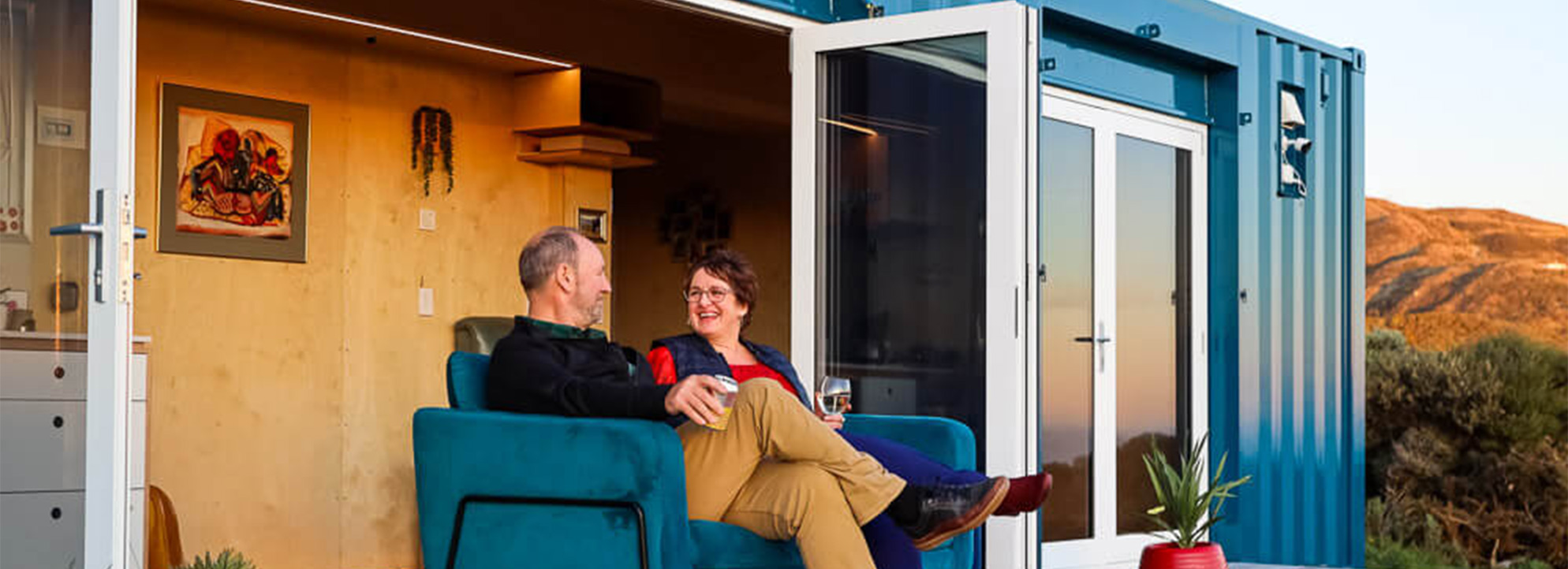

News & Articles
Shipping container homes in New Zealand: From design, to planning, to inspiration.
With a comparatively low cost, comparatively high sustainability, and fairly fast turn-around, shipping container homes have emerged as a smart and savvy option. Luckily for us, there’ve been a fair few lessons learned by those plucky people who’ve already embarked on a container home journey of their own.
This guide covers...
- What is a shipping container home?
- Do shipping container homes need building or resource consent?
- What are the New Zealand container home regulations?
- How do you convert a shipping container into a home?
- What does a shipping container home cost?
- What determines the cost of a shipping container?
- Our top 5 reasons to build a shipping container home
- How to insulate a shipping container home
- How long does it take to build a shipping container home?
- Inspiring New Zealand container home designs
- Is a shipping container home right for you?
- Ready to take the next step towards a container home of your own?
What is a shipping container home?
Shipping container homes have all the mod-cons and comforts of a traditionally built home – like a kitchen, bathroom, laundry, bedrooms, living rooms and decks. There’s just one major difference; they’re built from shipping containers.
Each individual container is carefully fabricated (usually off-site), in line with New Zealand building codes. Then they’re transported to the site, where – like a giant game of Tetris – they’re put into place by qualified builders, before finally being fixed onto their foundations.
Also just like Tetris, the configuration of every container house will be different. Each is built based on the site’s specific shape and aspects, its own unique floor plan, and how much cash the person building it has to spare.
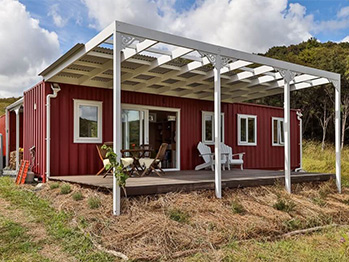
40ft container home in Northland, NZ. Source: livingbiginatinyhouse.com
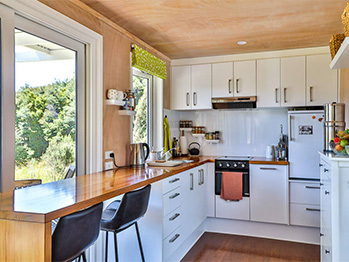
All the mod cons. Source: livingbiginatinyhouse.com
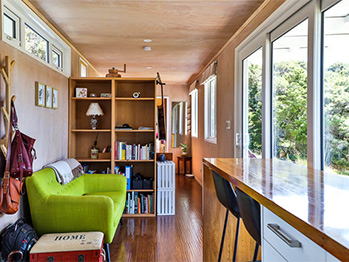
Timber floors and cozy furnishings make for a homely interior. Source: livingbiginatinyhouse.com
Do shipping container homes need building or resource consent?
This is a great question, and there’s no one cut-and-dry answer. It will all depend on variables like where your shipping container home will be placed, and what it’ll be used for. Requirements can also change depending on your local council.
That said, if you’re using shipping containers to create a home or dwelling, building consent will likely be required to make sure the final product is up to code.
If the container home could have any kind of impact on its environment – or its neighbours – it may well need resource consent, too.
If your individual shipping containers are particularly big or heavy, it may also pay to check whether you need transport permits to get them from the depot to your site. If you source your containers from a trusted supplier like SCF NZ, we can sort these transport logistics for you.
What are the New Zealand container home regulations?
New Zealand shipping container homes need to meet the requirements and regulations of the specific Council they’re located in. These regulations can vary across the country, so before you start any groundwork, it’s important to do your homework.
Like traditional houses, shipping container homes in NZ also need to meet the standards of the NZ Building Code. So do your research into any building codes attached to water, heating, sewage, and electricity – anything your shipping container house needs to turn it into a warm and comfortable home. Then make sure you get your required permits sorted well ahead of time, to avoid any regulations-related delays.
How do you convert a shipping container into a home?
Think of shipping containers like a blank building canvas. They provide a basic shell, which you’ll need to convert to make work for your home’s unique design. And that’s one of the great things about containers. When it comes to modifications, the world is truly your oyster.
You can add features like:
-
Footing and foundations
-
Windows
-
Internal doors
-
Ventilation
-
Insulation
-
Plaster
-
Plumbing
-
Electrical
-
Flooring
-
Roofing
Each of these features will come at an additional cost, and your plan will need to outline every one of them in great detail. This is the same plan that you’ll rely on for any building permits required, so it needs to be solid – preferably designed by an architect or engineer.
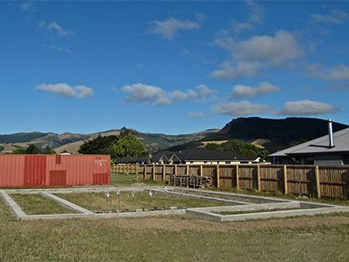
Container home foundations, Kuziel family project. Source: kuziel.nz
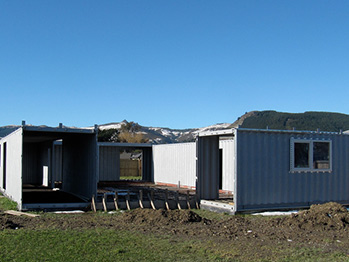
Containers in place with custom windows and door opening. Source: kuziel.nz
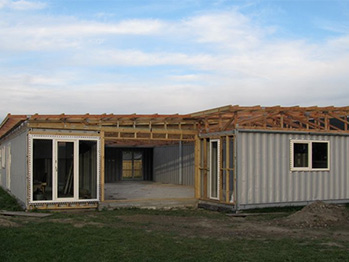
Additional framework to bring the vision to life. Source: kuziel.nz
What does a shipping container home cost?
As they say, how long is a piece of string? The answer will all depend on a wide range of factors. Like your home’s size, the complexity of its plans, the trickiness of its site access, the materials you choose to build with, and a whole raft more.
So to keep things simple, let’s look at purely the shipping container part of the cost equation.
-
A 20ft high cube container can cost anywhere from $3,850 to $9,350.
-
A 40ft high cube container can cost anywhere from $5,405 to $10,925.
Note that this estimated cost covers one shipping container only. It doesn’t include any additional costs such as building plans, approvals, electrical, plumbing, flooring, insulation, windows, roofing, gutters, painting, transport to the site, and more.
Average 20ft container home build price
According to Statista, the average size of a new-build home in New Zealand in 2023 was about 141m2. Based on that number, you’d need about 11 x 20ft high cube containers to build the average-sized Kiwi home.
With an individual 20ft high cube container setting you back between $3,850 to $9,350, that means the shipping containers alone could cost anywhere from $42,350 to $102,850. Note, that cost excludes any of the modifications and extras mentioned above.
Average 40ft container home build price
Based on the same house-size average of 141m2 you’d need approximately 6 x 40ft high cube containers for your home. At a cost of $3,850 to $12,650 for each unit, the 6 containers alone – again, minus any modifications – may need somewhere between $23,100 and $75,900 of your budget.
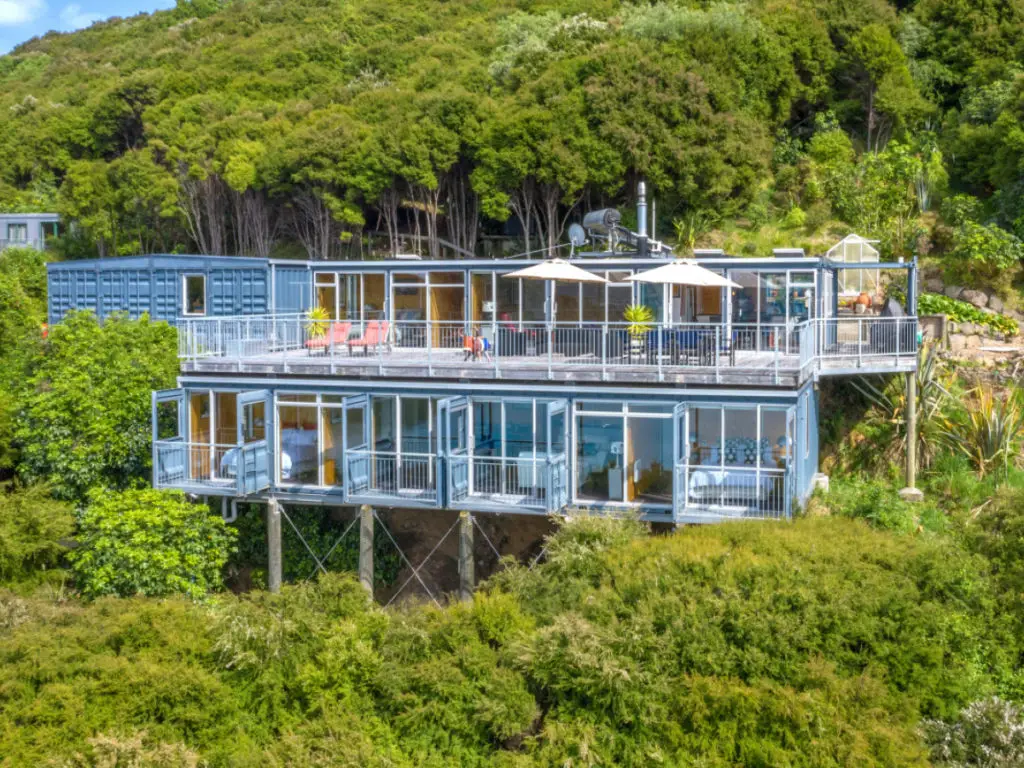
12+ 20ft Shipping Containers used in the construction of this container home, Akaroa Harbour, NZ. Source: livinginacontainer.com

Tranquil views of Akaroa Harbour. Source: livinginacontainer.com
What determines the cost of a shipping container?
From its condition, to its size, to market conditions and demand, the price of an individual shipping container can be chalked up to a huge range of considerations.
For more detail on what drives the costs of shipping containers, check out our guide, Shipping Containers for Sale & Hire Price List. Or read on below for a few key factors to consider when figuring out how much of your budget may need to be set aside for shipping containers.
1. How many containers do you need for your design?
The number of containers you need will be led by your home’s unique design – starting with its size. If you’re building a tiny home (or something even smaller) your shipping container costs could be kept very low. But the bigger the container home, the more containers it’ll need. And the more containers it needs, the more it’ll cost.
Your home’s design will also influence the number of modifications your containers need. A plan filled with additional doors, windows, wall removals, and special features – all of which need to be done with proper due diligence and care, to maintain structural integrity – will be more expensive than a design that keeps things plain and simple.
2. What size containers will you need?
Here in New Zealand, to be deemed ‘habitable’ a room needs a ceiling height of at least 2.4m. Unfortunately, this means general purpose shipping containers – at just 2.39m ceiling height – fall short by just a centimetre.
That’s why the pricing calculations in this guide have been worked up based on the cost of a high cube shipping container. With a ceiling height of 2.7m, high cubes clear the minimum height requirements by a good 30cm. Leaving plenty of room for all the essentials like electrical work, plastering, and proper insulation.
So, we know your shipping container home will need to use high cube containers. But what about 20ft vs. 40ft containers? The choice between the two will likely be led by your container home’s unique design. But if you wanted to make a decision based purely on the dollars, 40ft high cube containers tend to work out better value for $$ per m2 than their 20ft cousins.
For more on what various shipping containers cost – and why – we recommend checking out our comprehensive guide, Shipping Containers for Sale & Hire Price List.
3. What condition will your containers be in?
A container’s condition is a major factor in where it’ll fall on that rough $3,850 to $12,650 pricing spectrum. Brand new containers will be in mint condition, while much newer second-hand options will be far cleaner and tidier, with less wear and tear. Both will be priced significantly higher than their more well-used counterparts.
Older containers that’ve been in regular use will be far cheaper, but will come with much more general wear and tear. They could also have been used to store things like car parts, chemical-filled paints, or other potential nasties you might not want anywhere near your new home.
Unfortunately there’s no way of knowing for sure what a second-hand shipping container has been used for. But when you source your containers, your supplier should be able to tell you whether an individual unit is appropriate to be used to build your home.
4. How closely will you stick to your plans?
Just like any other new build, making changes to your shipping container home design once your plans are set in stone will always cost you extra.
Depending on the scope of the changes, they could call for extra welding, cutting, or even having to start from scratch with a fresh container. Which, when you’re already part-way through a container home build, is far easier said than done.
So once your shipping containers have been fabricated and finalised, it pays to try and keep any changes to a minimum.
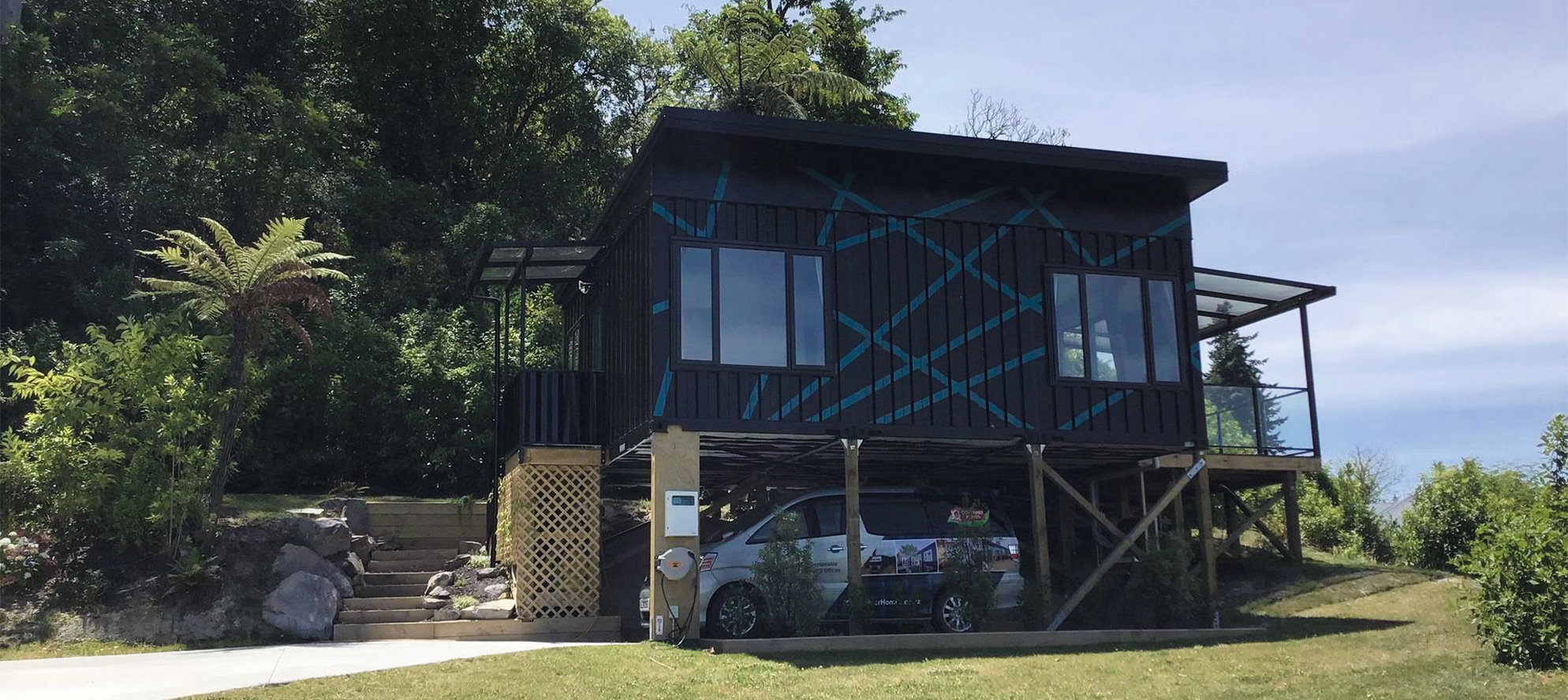
Three 20ft shipping containers were used in the construction of this home in Lake Taupo, NZ. Source: Archipro.nz
Our top 5 reasons to build a shipping container home
Shipping container homes are only gaining in popularity, largely because there are just so many benefits that come with them. From the obvious to the unexpected, here are 5 of our favourite reasons to choose to build a shipping container home.
1. Every container home is different
You might think number 1 on our list would be ‘because they’re quick and easy to build’. But like any other home build, container homes don’t always turn out as quick and easy as you’d think.
Instead, one of our very favourite things about container homes is their originality. Container homes bring a modern and industrial aesthetic to the table that off-the-plans traditional homes just can’t capture.
Shipping container homes tend to be masterfully designed by architects or builders, led by clients who have a clear and bold vision. This means container homes tend to be wholly individual, and utterly unique.
2. Container homes are more sustainable
Shipping containers land in New Zealand from overseas, and the cost of sending them back to their country of origin is often too high to be commercially viable. This means a significant number of second-hand containers end up sitting unused in yards across the country.
Giving these shipping containers a second life by using them to build your dream home is a great way to be good to the environment.
3. Shipping container homes are cost-effective
This is one of the main drivers behind shipping container homes’ growing popularity. With the prices of new home builds sky-rocketing, savvy homeowners are always looking for innovative new ways to cut costs.
While shipping containers can still be a low-cost way to build, they’re not immune to the impacts of the evolving economy. Weak exchange rates, inflation, and availability issues have all significantly pushed up the price of shipping containers. Plus, depending on your dream home’s design, using shipping containers may only add to the complexity of the build – and to its cost.
So, while a container home can still be a cost-effective way to go, it’s important to get a clear idea of pricing before you get too deep into planning.
4. Containers are endlessly customisable
Most container homes in New Zealand are designed from scratch by architects, builders, or creative homeowners – rather than bought off-the-plans.
This makes them highly customisable, which makes them an attractive option for anyone looking for a home tailored to their own needs and tastes.
Shipping containers are essentially either a 20ft or 40ft rectangle – making them an ideal blank canvas for almost limitless possibilities and configurations. Single-level or double-story, nestled into their surroundings or standing proudly apart. The container’s industrial-style walls could become internal design features. Or a container could be used to create a clever cantilevered space.
However you choose to customise your container home, it’s sure to stand out.
5. Durability is second nature
Shipping containers are built from steel, and made to withstand New Zealand’s harshest environments and conditions. Different containers will have different lifespans, depending on what they’re used for.
-
Containers used for rail or road freight last 10+ years (because their frequent use leads to more damage and corrosion)
-
Containers used for static storage can last up to 25 years (because they’re moved less often, so experience less structural damage)
-
Containers used for shipping container homes could last for over 50 years.
That’s right – with proper maintenance (like a good clean and fresh coat of paint every 5-7 years) a shipping container home could last for more over half a century. This is down to a few key reasons.
-
A container home’s foundations protects its base against soil, salt and water damage
-
Adding a roof stops water pooling on the container top, which decreases the risk of rust
-
Containers used for homes tend to be in fairly good condition, meaning they start out with less rust, more robust structure, and minimal wear and tear.
How to insulate a shipping container home
Like we’ve mentioned, a shipping container provides no more than a basic steel shell. This means they lose (and gain) heat and cold rapidly, and need proper insulation installed to make them livable.
At SCF NZ, our portable building containers – like the 20ft Site Office – use Rockwool insulation. It’s long-lasting, hard-wearing, and fire-safe, making it a solid insulation option.
How long does it take to build a shipping container home?
With consents, permits, site prep, Council approvals and container deliveries all done and dusted, it’s finally time to power-up the tools and start building your container home.
Once construction actually gets going, building your shipping container home can be a comparatively quick process. Of course, this will also depend on the complexity of your design, and factors like whether your home is made solely of containers, or a combination of containers and more traditional building techniques.
For a straightforward container-only home, once every container has been prefabricated offsite, it can be delivered and placed into its final position all in the same day. Then it’s time for any additional work needed – like welding the containers safely (and permanently) together.
When every container is put into position, the home’s internal work will begin. That includes insulation, plumbing, electrical, plaster, flooring, roofing, all fittings and frames, and more. The timeline for this internal work will be fairly in line with a traditional home build.
Mountain-view Container Cabin in Glenorchy
The recently-built Glenorchy Mountain Retreat is less container home, more container haven. The small home is made from a single converted shipping container. It’s kitted out with every mod con you could expect, plus a few you couldn’t (like its very own disco ball!). Best of all, it’s available to book via AirBnB.
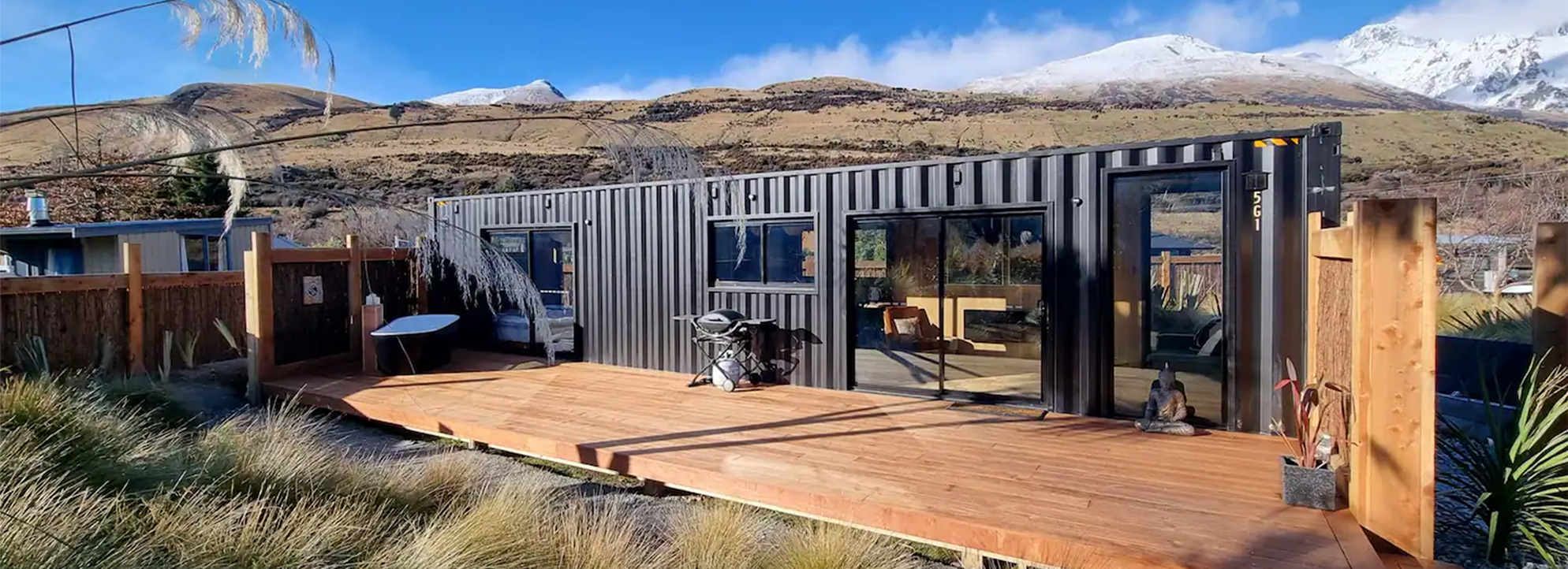
Container retreat in Glenorchy. Source: AirbBnB
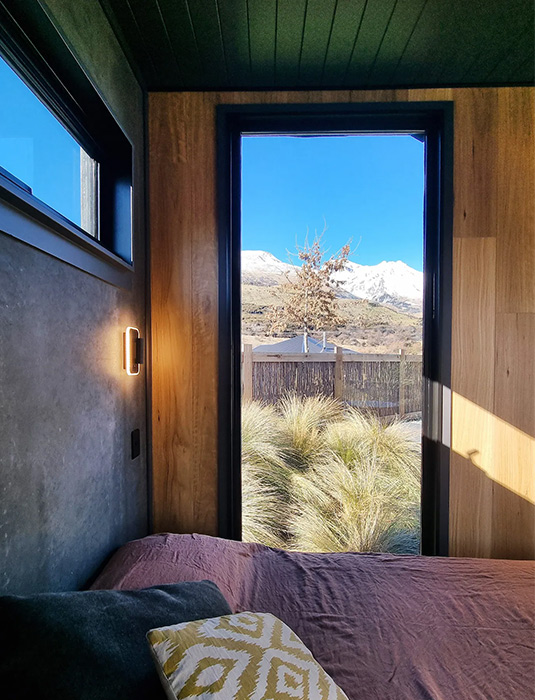
View from the bedroom. Source: AirBnB

Lounge room. Source: AirBnB
Grand Designs Container Home on Waiheke
Featured on a 2022 episode of Grand Designs, this stunning home is a showcase in what can be achieved with the humble shipping container. Designed by architect Chris McCarthny, the home’s complex configuration pushed its five 20ft and two 10ft shipping containers’ structural integrity to their limits. The result? A home that skilfully blurs the lines between the final modern masterpiece, and the industrial containers that ground it.
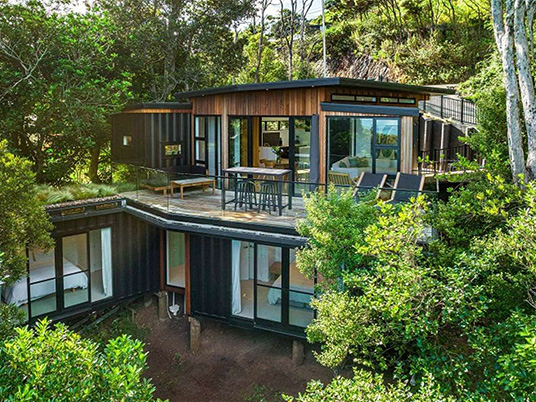
A Grand Design - The exterior of Waiheke's finest container home. Source: OneRoof

Not a bad backyard. Source: OneRoof
Iconic Container Home in Wellington
Precariously perched on a rockface, this legendary Happy Valley container home was one of the country’s first. The three-bedroom home grew slowly over time – starting with one container in 2003, a second added in 2007, before finally settling into its current three levels. Constructed using refrigerated containers, the 90m2 home is fully insulated. And complete with a spiral staircase, outdoor shower, media room, and waterfall.
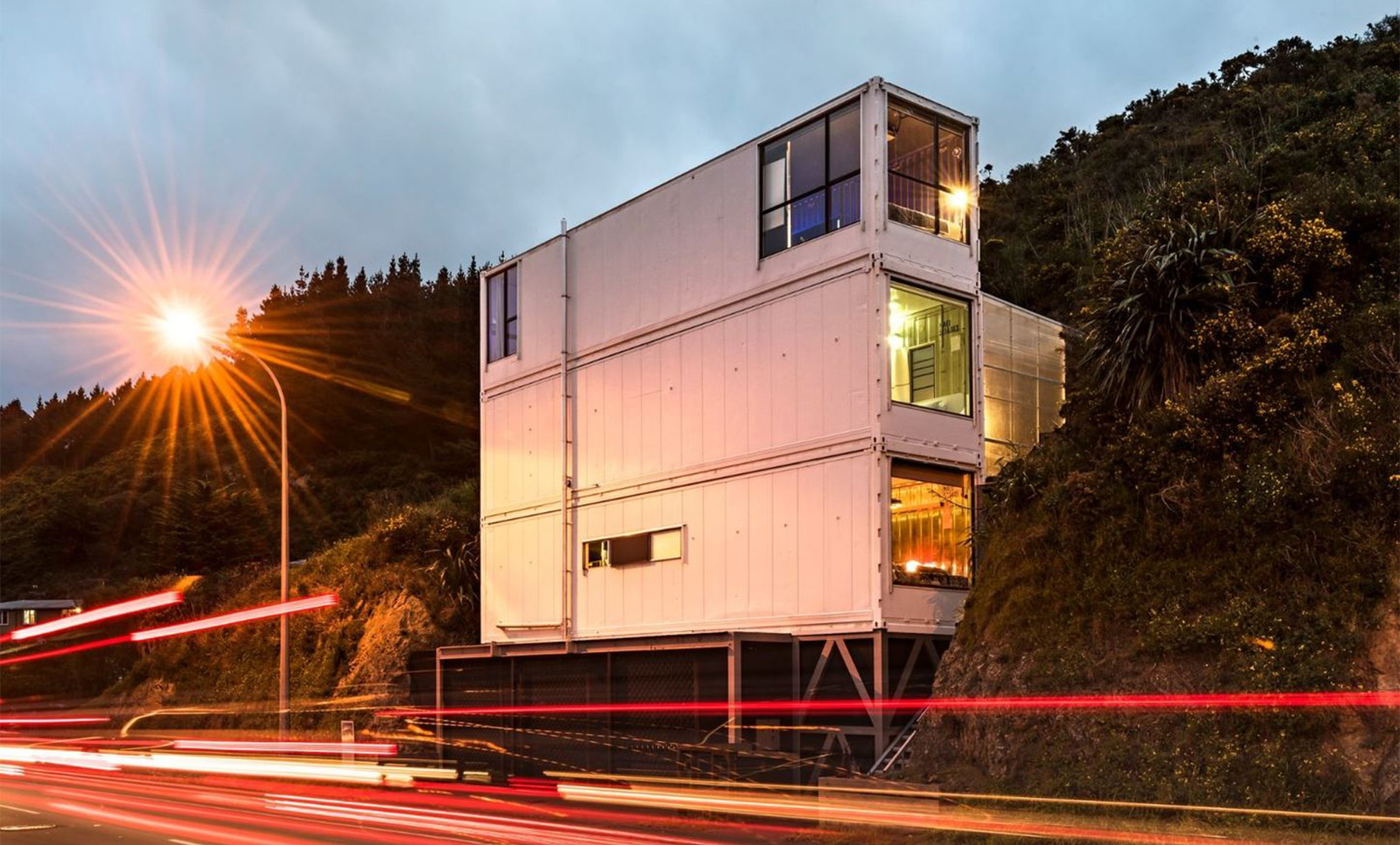
Iconic. Source: NZ Herald
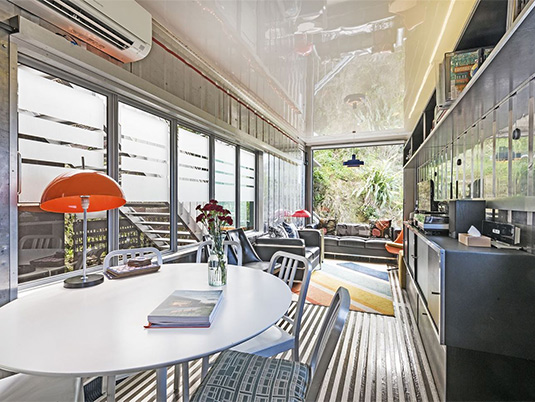
The converted refrigerated container makes a cozy living area. Source: NZ Herald
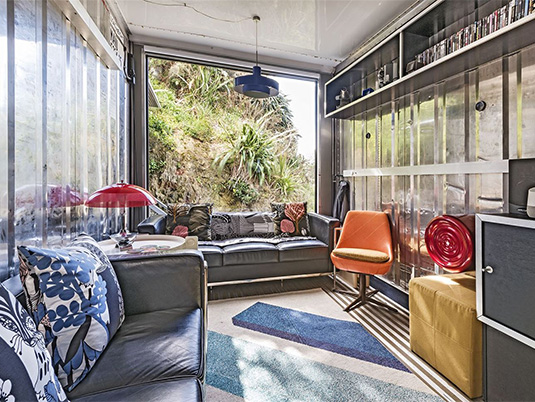
Nature views. Source: NZ Herald
Off-the-grid Container Cabin just outside Coromandel Town
Less than half an hour’s drive from Coromandel Town, you’ll find the charming Ahurewa Eco Retreat. Built in 2020, this shipping container cabin is entirely off-the-grid and self-sufficient. The simple retreat-style dwelling includes a bedroom, living and kitchen area, and bathroom – all of which feel right at home within their native bush surrounds. But don’t take our word for it…book a stay, and experience its magic for yourself.
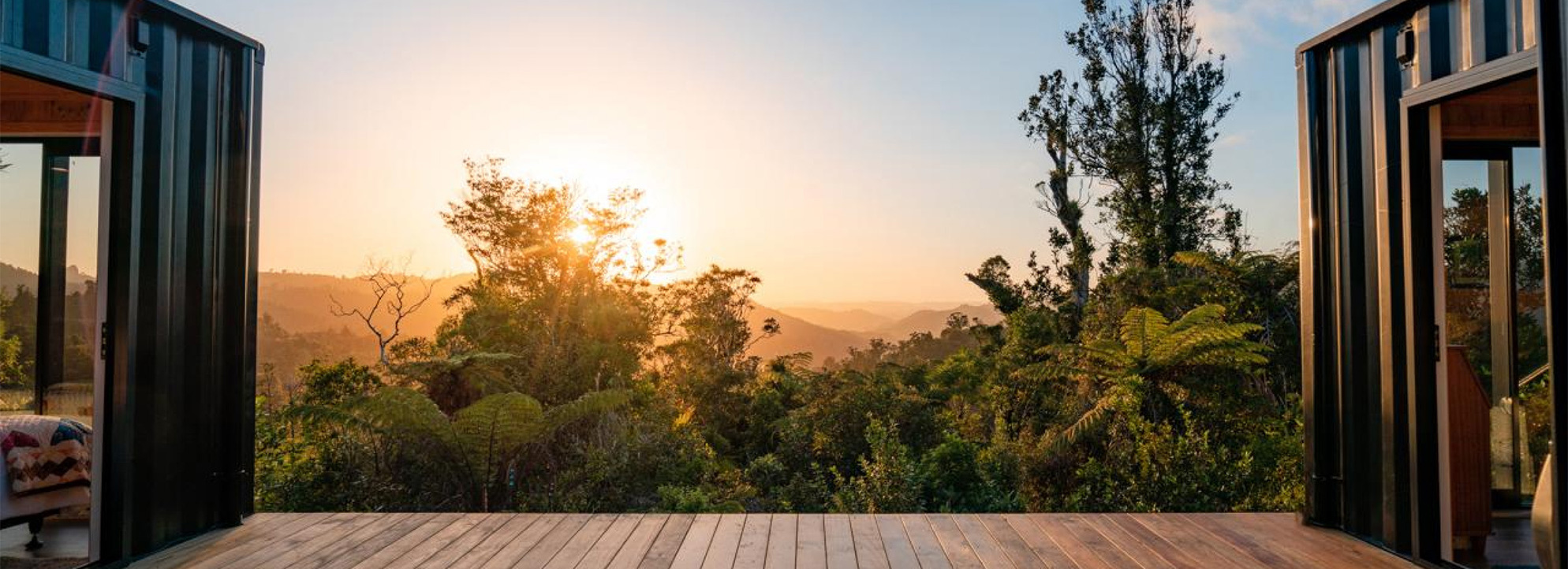
Amazing sunset views. Source: thecoromandel.com

Stunning location. Source: thecoromandel.com

Could things get any more beautiful? Source: thecoromandel.com
Is a shipping container home right for you?
Like so many other questions surrounding shipping container homes, it all depends. If you’re opting for a shipping container home purely to save on cash, you might want to reconsider. Since container homes first emerged in the 2010s, the price of building them has grown significantly. It takes a lot of fabrication to get shipping containers up to the specs of a modern home – and that comes with a price tag attached. All of which is to say, a traditional build may well end up being the more cost-effective (and at times straightforward) option.
But low costs aside, there are so many other great reasons to choose a container home. They stand out and make a big visual impact – while minimising their impact on the environment. They’re hardy and robust, capable of withstanding the harsh Kiwi elements. They tend to be totally unique, with a contemporary industrial aesthetic that’s hard to recreate with other more standard building materials. And if you ask us, that’s a lot of big new-home-build boxes to tick.
Ready to take the next step towards a container home of your own?
If you’ve talked to an architect or builder and have landed on what you’re looking for, now’s a great time to talk to SCF NZ. We supply quality shipping containers for both commercial and residential projects, and we can help source the right 20ft and 40ft shipping containers for you.
Finding the right containers for your build can take time – especially if you need three or more, and are looking for specific sizes, specs, and conditions. So when it comes to reaching out and getting started, the sooner the better.
Subscribe & stay informed
Receive the latest in products, trends, news, events and tips.
